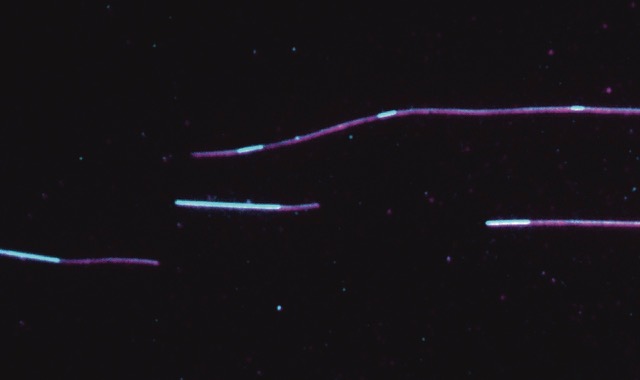
Tau (cyan) island formation on microtubules (magenta) in vitro. ©Siahaan et al.
The cytoskeleton is a filamentous protein network in cells. Among other roles, the filaments of the cytoskeleton serve as tracks for the transport of intracellular cargo. In neurons, molecules necessary for synapses are transported great distances along these tracks. Malfunctions in this transport can lead to the death of neurons – by a process called neurodegeneration.
An important factor involved in neurodegenerative diseases, such as Alzheimer's disease, is the protein Tau. Tau protein stabilize microtubules, which are part of the cytoskeleton that serve as tracks for intracellular transport in neurons. Importantly, Tau can protect microtubules from microtubule-degrading enzymes. However, how Tau carries out this regulatory function is still unclear. Just published in the journal Nature Cell Biology, an international team of scientists from the Institute of Biotechnology, BIOCEV in Prague, the B CUBE - Center for Molecular Bioengineering at the Technische Universität Dresden, and the Max Planck Institute of Molecular Cell Biology and Genetics show evidence that Tau proteins can form a protective layer on the microtubule surface by forming cohesive islands.
The authors of the study found that Tau molecules can be bound to the cytoskeletal filaments in two distinct ways, as single independent molecules, or as a cohesive structure of many tau molecules that is still in dynamic equilibrium with tau in the surrounding media. They named these structures islands. These islands generate a protective layer on the filaments that protects them from degrading enzymes and restricts the movement of various transporters.
The reported results suggest that cohesive structures of tau protein are not only related to pathological states and neurodegeneration, but likely also bears important function for other physiological processes carried out by Tau molecules in our cells.
Siahaan, V., Krattenmacher, J., Hyman, A. A., Diez, S., Hernández-Vega, A., Lansky, Z., & Braun, M. (2019). Kinetically distinct phases of tau on microtubules regulate kinesin motors and severing enzymes.
Nature Cell Biology, 21, 1086-1092. doi.org/10.1038/s41556-019-0374-6